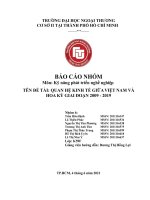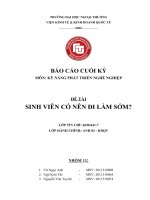BÁO CÁO NHÓM KỸ NĂNG PHÁT TRIỂN NGHỀ NGHIỆP Tiêu đề ELDERLY TECH TUTORS
Bạn đang xem bản rút gọn của tài liệu. Xem và tải ngay bản đầy đủ của tài liệu tại đây (300.01 KB, 28 trang )
<span class="text_page_counter">Trang 1</span><div class="page_container" data-page="1">
<b>TRƯỜNG ĐẠI HỌC NGOẠI THƯƠNGCƠ SỞ II TẠI THÀNH PHỐ HỒ CHÍ MINH</b>
<b>---***---BÁO CÁO NHĨM</b>
<b>KỸ NĂNG PHÁT TRIỂN NGHỀ NGHIỆP (KDOE441)Chuyên ngành : Kinh tế đối ngoại</b>
</div><span class="text_page_counter">Trang 2</span><div class="page_container" data-page="2"><b>TABLE OF CONTENTS</b>
<b>CHAPTER 1. BACKGROUND INFORMATION...2</b>
1. Introduction...2
2. Research...3
<b>CHAPTER II. OBJECTIVES...5</b>
<b>CHAPTER III. ACTIONS...7</b>
1. Brief - Tech education workshop...7
2. The unique value of the workshop...8
3. Information about the workshop...9
4. Media plan...9
5. Masterplan...10
5.1. Pre-onsite...10
5.2. Onsite...12
<b>CHAPTER IV. REQUIRED RESOURCES AND RESOURCE ALLOCATION19</b> 1. Attracting and Retaining volunteers...19
5. Total money spending for the project...24
<b>CHAPTER V. MONITORING AND EVALUATION...25</b>
<b>CHAPTER VI. RISKS AND RISK MANAGEMENT...27</b>
1. Risks...27
2. Risk management...27
<b>References...29</b>
</div><span class="text_page_counter">Trang 3</span><div class="page_container" data-page="3"><b>CHAPTER 1. BACKGROUND INFORMATION</b>
<b>1. Introduction</b>In today's fast-paced digital world, it is increasingly important to ensure that older adults have the opportunity to learn about and use technology. The majority of Vietnamese elderly citizens, specifically those having to reside in nursing homes, are not well-versed in technology and do not make use of the available digital assistance. Some are clueless about such innovations, while others are still afraid to seek education from younger generations.
<b>2. Research</b>
Several factors contribute to building this barrier, such as limited exposure to technology in their younger years, the rapid pace of technological advancements, and the uncertainty and hesitance of the elderly themselves. This barrier poses a challenge for them to develop digital capabilities in order to stay connected, informed, and active in society. According to research conducted in 2018 and published in 2021 by the Institute of Population, Health, and Development (PHAD) with the participation of 6,050 elderly people in 654 communes and wards of 10 provinces and cities in Vietnam, only about 6.4% of elderly people can use social networks and 12.7% of elderly people can access the internet<small>[ CITATION Hoà22 \l 1033 ]</small>. This statistic demonstrates the lack of technological knowledge among the older population in Vietnam.
Despite that, studies have shown quite interesting results regarding the elderly's use of the Internet. In China, a professor at Tsinghua University interviewed over 60-year-olds between 2018 and 2020, and the results indicated a higher level of happiness among internet users than non-users. Although there have not been large-scale studies on this topic in Vietnam, researchers have made some basic observations regarding the impact of technology on the elderly. However, there are some risks that engaging with technology without proper understanding can entail. According to the Kaspersky study, 86% of senior citizens with internet access do not believe they are targets of cybercriminals and hence do not take appropriate precautions. Additionally, studies reveal that, compared to younger generations, elderly adults are almost seven times
</div><span class="text_page_counter">Trang 4</span><div class="page_container" data-page="4">more likely to spread false information on Facebook (News Department of VTV, 2022).
In conclusion, the majority of elderly citizens, specifically those living in Vietnam, are currently facing three problems when it comes to technology: a lack of education on this matter, a sense of uncertainty, and vulnerability to cyber criminals. "Elderly Tech Tutors" is a social project created to address these hardships, empower those who are afraid, and provide assistance to those who are ready to embark on a brand new journey of technological exploration.
</div><span class="text_page_counter">Trang 5</span><div class="page_container" data-page="5"><b>CHAPTER II. OBJECTIVES</b>
We can assist older individuals by making technology more accessible and supportive. This helps them gain numerous benefits from technology and therefore live longer, healthier, and more fulfilling lives. Some of those benefits are as follows:
<b>1. Enhance connections and relationships: By embracing digital communication</b>
platforms, such as video calling apps, social media, and messaging services, old people can cross geographical distances and retain meaningful relationships with their loved ones. This will be even more valuable if they are living far away from their children, friends, and relatives. As a result, this will alleviate feelings of loneliness and isolation tremendously, as well as strengthen familial bonds and relationships.
<b>2. Access to a myriad of recreational content: Old people each have their own</b>
hobbies and preferences when it comes to how they like to entertain themselves. Knowing how to make use of technology and various online platforms will greatly facilitate them in pursuing their hobbies. For example, e-readers and audiobooks have made it easier than ever for older book lovers to access their favorite works, regardless of their physical limitations; for avid music listeners, Spotify and YouTube are the two most popular streaming services in Vietnam, which offer older adults a great variety of music to explore and enjoy, catering to their diverse tastes.
<b>3. Valuable health assistance: Technology is an excellent tool for managing elderly</b>
people's health and well-being. In a typical nursing home setting, where the number of patients often exceeds the available caregiver resources, it will be a great help to
<b>implement an effective technology system to keep track of each patient's health</b>
condition. For example, wearable gadgets, such as smartwatches and fitness trackers, can monitor seniors' physical activity, heart rate, and sleep patterns, which may alert them to potential health threats as well as encourage a more active lifestyle (Salter, 2023). This application of digital devices ultimately enhances patient care and their quality of life.
<b>4. Easier to complete day-to-day tasks: Technology has also made daily errands</b>
much faster and more convenient for older citizens. For instance, seniors may read the news online by browsing their favorite news websites or downloading a news app,
</div><span class="text_page_counter">Trang 6</span><div class="page_container" data-page="6">which helps them keep up with current events without buying a real newspaper. Apart from that, they can easily access their bank account to make transactions and check their balances, which saves them the arduous and lengthy trip to the bank and back. Having these services at their fingertips will reduce the physical and mental effort required to perform them, resulting in more time to rest and engage in meaningful activities.
</div><span class="text_page_counter">Trang 7</span><div class="page_container" data-page="7"><b>CHAPTER III. ACTIONS</b>
<b>1. Brief - Tech education workshop</b>
Organize workshops or training sessions to teach elderly individuals how to use smartphones, tablets, computers, and relevant apps. This could cover basics like using email, video calls, social media, and relevant apps for health tracking, medication reminders, etc.
- Assessment of Needs: Before organizing workshops, conduct surveys or interviews with the elderly community to understand their current level of tech literacy, the specific areas they need help with, and their interests in learning about technology.
- Workshop content: Develop a curriculum that starts with the basics and gradually progresses to more advanced topics based on the participants’ needs and comfort levels. Some topics to cover may include:
o Introduction to devices: explaining different types of devices (smartphones, tablets, and computers), their functionalities, and how to navigate them.
o Internet basics: teaching how to use a browser, search engines, and access reliable information online.
o Communication tools: Demonstrating how to use email, messaging apps, and video calling software to connect with family and friends
o App usage: Introducing useful apps for health tracking, medication reminders, entertainment, etc.
o Online safety: educating participants about online threats, how to create strong passwords, recognizing scams, and protecting personal information.
- Hands-on learning: Organize interactive sessions where participants can practice using devices and applications. Encourage them to bring their own devices, if possible, to ensure they learn what they’re comfortable with.
- Visual Aids and Simplicity: Use large fonts, clear visuals, and simple language in training materials and presentations. Emphasize step-by-step introductions and offer handouts or guides for reference.
</div><span class="text_page_counter">Trang 8</span><div class="page_container" data-page="8">- Patience and Support: Be patient and understanding. Some elderly individuals might feel intimidated or anxious about technology. Offer individualized assistance and encourage peer support among participants.
- Engagement and interaction: Incorporate activities, group discussions, or Q&A sessions to keep participants engaged and encourage interaction among them. Sharing success stories or experiences can boost confidence.
- Regular sessions and follow-ups: Conduct workshops regularly to reinforce learning and cover more advanced topics as participants progress. Follow-up sessions or one-on-one assistance can help address specific challenges or questions.
- Accessible venue and equipment: Ensure the venue is accessible, comfortable, and equipped with the necessary technology (projectors, screens, internet connectivity) for effective teaching and practice.
- Feedback and evaluation: Collect feedback from participants after each session to understand what worked well and what needs improvement. We can also use this input to refine future workshops.
- Collaboration and resources: collaborate with local organizations, tech experts, or volunteers who can contribute resources, expertise, or guest sessions to enhance the workshops.
<i>*Note: The goal is not just to teach technology but also to build confidence andempower elderly individuals to use technology to improve their lives. Therefore,flexibility and adaptability in meeting their specific needs will be crucial for thesuccess of these workshops.</i>
<b>2. The unique value of the workshop</b>
The workshop dedicated to aiding elderly individuals with technology offers a unique and personalized approach tailored to address the distinct challenges faced by this demographic. Therefore, it stands out by delivering customized learning experiences, focusing on practical and relevant content crucial for older adults, including health apps and online safety measures. Through patience and adaptability, the workshop fosters empowerment, independence, and social connectivity, reducing isolation and enhancing mental well-being. Its holistic approach covers diverse aspects
</div><span class="text_page_counter">Trang 9</span><div class="page_container" data-page="9">beyond basic skills, emphasizing ongoing support and engagement, thereby improving the overall quality of life for elderly participants. Furthermore, by showcasing measurable impacts such as increased digital literacy and enhanced social connections, the workshop demonstrates the tangible value and immense potential of technology in enriching the lives of older adults.
<b>3. Information about the workshop</b>
- Name: OLD NOT “SLOW” - Place: A nursing home in HCMC - Time: 6, 7/7/2024
- Attendances: 25 volunteers and the board of the program organization (5 people); 50 elderly people in said nursing home.
Introduce about the workshop: who are we and what are our
List some activities that will be done in the workshop.
4 Q&A <sup>Answer the questions that </sup>
people are wondering. <sup>27/6/2024</sup> 5 Countdown <sup>Countdown 3 hours left to </sup>
</div><span class="text_page_counter">Trang 10</span><div class="page_container" data-page="10">Thank you for participating, describe the exciting
Send information about the workshop to the
nursing home.
2 3-16/6/2024 Contact sponsor The main reason why sponsors would want to invest in this project is to improve their brand image, since sales might not
</div><span class="text_page_counter">Trang 11</span><div class="page_container" data-page="11">3 3/7/2024 <sup>Information day (nursing</sup> home)
Inform the nursing home about the date, time, scale (how many people are likely to show up), and any necessary assistance from the nursing home; for example, if they can spread the
information about this workshop to the elderly people there and provide any
Tell the volunteers what they are
The staff (which consists of the Board of program organization and 25
Preparation is crucial to the success of a
</div><span class="text_page_counter">Trang 12</span><div class="page_container" data-page="12"><b>PHASENO. TIMELINECONTENTNOTE</b>
volunteers) shows up at the venue, bringing necessary equipment, including the 25 phones provided by
sponsors, lights, cameras, standees, souvenirs, water, etc.
Then, these people are divided into three groups: 1.The first one is in charge of setting up the above-mentioned devices, making arrangements regarding seating of audiences and sponsors' representatives, and decorating the venue in accordance with the
workshop's topic with standees and banners. 2.The second group, which consists of those who will be giving a presentation and demonstration on the topic, will find a quiet and
secluded place to rehearse one last time, make
necessary adjustments, and mentally prepare for the
</div><span class="text_page_counter">Trang 13</span><div class="page_container" data-page="13"><b>PHASENO. TIMELINECONTENTNOTE</b>
responsible for improvising and communicating with the nursing home's staff in case of any unexpected situation and also has the duty to go greet the sponsors'
representative and take them to their seat later on.
Around 50 elderly people from the nursing home and the sponsors' representative begin to show up at the venue. Half an hour is a reasonable amount of time for them to arrive and settle in their seats.
The first and third group try
The volunteers put on a small performance to lighten
1. Introduce the topic and objectives of this workshop, and extend gratitude to everyone who has shown up.
This is when everybody's attention is still high; try to
</div><span class="text_page_counter">Trang 14</span><div class="page_container" data-page="14"><b>PHASENO. TIMELINECONTENTNOTE</b>
2. Introduce the sponsors. 3. Introduce the audiences to technology and digital devices: what they are, why they are important in our daily lives, and how the elderly can utilize their potential to make life easier and more fulfilling.
Introduce the Internet and its basic functions, such as search engines, browsing
Take a short 10-minute break to recharge the energy.
Demonstrate <b>with a real device</b> how to use digital communication tools, such as messaging services, face calling, and email.
Demonstrate <b>with a real device</b> how to use basic apps, such as social media, search engines, health
</div><span class="text_page_counter">Trang 15</span><div class="page_container" data-page="15"><b>PHASENO. TIMELINECONTENTNOTE</b>
trackers, news apps, online banking, and so on.
you are trying to do.
A PowerPoint slide or any kind of visual aid that
Q&A session, where the audience asks questions about what they have just learned but still find hard to understand.
Try to wrap up the show by 10:30, which means the Q&A session can only
Practice session, in which one volunteer will be in charge of instructing and supervising two elderly people at the same time. He or she will carefully and
Each group takes a
maximum of <b>1 hour</b>.
</div><span class="text_page_counter">Trang 16</span><div class="page_container" data-page="16"><b>PHASENO. TIMELINECONTENTNOTE</b>
patiently guide them through different steps while
answering any question that may come up.
The procedure stays the same as the first day's
Give a presentation about safety and security
awareness while using digital devices and the
The second practice session, where the elderly apply what have been taught to perform desired activities. They can try messaging each other, browsing a news website,
</div>








